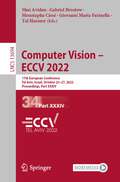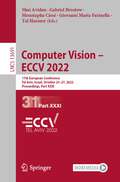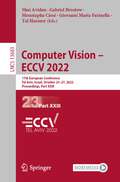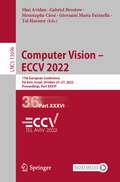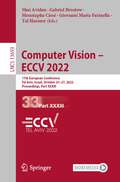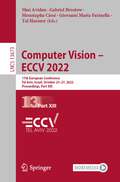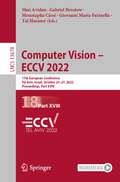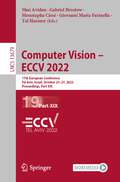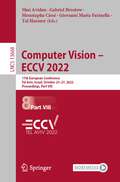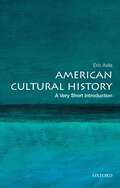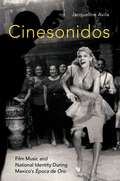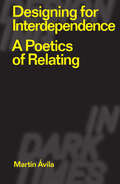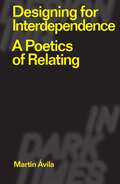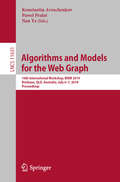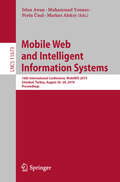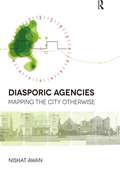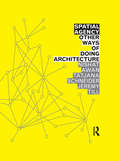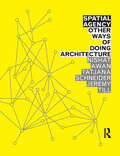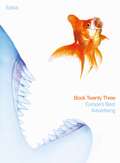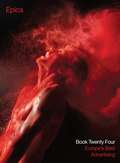- Table View
- List View
Computer Vision – ECCV 2022: 17th European Conference, Tel Aviv, Israel, October 23–27, 2022, Proceedings, Part XXXIV (Lecture Notes in Computer Science #13694)
by Shai Avidan Gabriel Brostow Moustapha Cissé Giovanni Maria Farinella Tal HassnerThe 39-volume set, comprising the LNCS books 13661 until 13699, constitutes the refereed proceedings of the 17th European Conference on Computer Vision, ECCV 2022, held in Tel Aviv, Israel, during October 23–27, 2022. The 1645 papers presented in these proceedings were carefully reviewed and selected from a total of 5804 submissions. The papers deal with topics such as computer vision; machine learning; deep neural networks; reinforcement learning; object recognition; image classification; image processing; object detection; semantic segmentation; human pose estimation; 3d reconstruction; stereo vision; computational photography; neural networks; image coding; image reconstruction; object recognition; motion estimation.
Computer Vision – ECCV 2022: 17th European Conference, Tel Aviv, Israel, October 23–27, 2022, Proceedings, Part XXXI (Lecture Notes in Computer Science #13691)
by Shai Avidan Gabriel Brostow Moustapha Cissé Giovanni Maria Farinella Tal HassnerThe 39-volume set, comprising the LNCS books 13661 until 13699, constitutes the refereed proceedings of the 17th European Conference on Computer Vision, ECCV 2022, held in Tel Aviv, Israel, during October 23–27, 2022. The 1645 papers presented in these proceedings were carefully reviewed and selected from a total of 5804 submissions. The papers deal with topics such as computer vision; machine learning; deep neural networks; reinforcement learning; object recognition; image classification; image processing; object detection; semantic segmentation; human pose estimation; 3d reconstruction; stereo vision; computational photography; neural networks; image coding; image reconstruction; object recognition; motion estimation.
Computer Vision – ECCV 2022: 17th European Conference, Tel Aviv, Israel, October 23–27, 2022, Proceedings, Part XXIII (Lecture Notes in Computer Science #13683)
by Shai Avidan Gabriel Brostow Moustapha Cissé Giovanni Maria Farinella Tal HassnerThe 39-volume set, comprising the LNCS books 13661 until 13699, constitutes the refereed proceedings of the 17th European Conference on Computer Vision, ECCV 2022, held in Tel Aviv, Israel, during October 23–27, 2022. The 1645 papers presented in these proceedings were carefully reviewed and selected from a total of 5804 submissions. The papers deal with topics such as computer vision; machine learning; deep neural networks; reinforcement learning; object recognition; image classification; image processing; object detection; semantic segmentation; human pose estimation; 3d reconstruction; stereo vision; computational photography; neural networks; image coding; image reconstruction; object recognition; motion estimation.
Computer Vision – ECCV 2022: 17th European Conference, Tel Aviv, Israel, October 23–27, 2022, Proceedings, Part XXXVI (Lecture Notes in Computer Science #13696)
by Shai Avidan Gabriel Brostow Moustapha Cissé Giovanni Maria Farinella Tal HassnerThe 39-volume set, comprising the LNCS books 13661 until 13699, constitutes the refereed proceedings of the 17th European Conference on Computer Vision, ECCV 2022, held in Tel Aviv, Israel, during October 23–27, 2022. The 1645 papers presented in these proceedings were carefully reviewed and selected from a total of 5804 submissions. The papers deal with topics such as computer vision; machine learning; deep neural networks; reinforcement learning; object recognition; image classification; image processing; object detection; semantic segmentation; human pose estimation; 3d reconstruction; stereo vision; computational photography; neural networks; image coding; image reconstruction; object recognition; motion estimation.
Computer Vision – ECCV 2022: 17th European Conference, Tel Aviv, Israel, October 23–27, 2022, Proceedings, Part XXXIII (Lecture Notes in Computer Science #13693)
by Shai Avidan Gabriel Brostow Moustapha Cissé Giovanni Maria Farinella Tal HassnerThe 39-volume set, comprising the LNCS books 13661 until 13699, constitutes the refereed proceedings of the 17th European Conference on Computer Vision, ECCV 2022, held in Tel Aviv, Israel, during October 23–27, 2022. The 1645 papers presented in these proceedings were carefully reviewed and selected from a total of 5804 submissions. The papers deal with topics such as computer vision; machine learning; deep neural networks; reinforcement learning; object recognition; image classification; image processing; object detection; semantic segmentation; human pose estimation; 3d reconstruction; stereo vision; computational photography; neural networks; image coding; image reconstruction; object recognition; motion estimation.
Computer Vision – ECCV 2022: 17th European Conference, Tel Aviv, Israel, October 23–27, 2022, Proceedings, Part XIII (Lecture Notes in Computer Science #13673)
by Shai Avidan Gabriel Brostow Moustapha Cissé Giovanni Maria Farinella Tal HassnerThe 39-volume set, comprising the LNCS books 13661 until 13699, constitutes the refereed proceedings of the 17th European Conference on Computer Vision, ECCV 2022, held in Tel Aviv, Israel, during October 23–27, 2022. The 1645 papers presented in these proceedings were carefully reviewed and selected from a total of 5804 submissions. The papers deal with topics such as computer vision; machine learning; deep neural networks; reinforcement learning; object recognition; image classification; image processing; object detection; semantic segmentation; human pose estimation; 3d reconstruction; stereo vision; computational photography; neural networks; image coding; image reconstruction; object recognition; motion estimation.
Computer Vision – ECCV 2022: 17th European Conference, Tel Aviv, Israel, October 23–27, 2022, Proceedings, Part XVIII (Lecture Notes in Computer Science #13678)
by Shai Avidan Gabriel Brostow Moustapha Cissé Giovanni Maria Farinella Tal HassnerThe 39-volume set, comprising the LNCS books 13661 until 13699, constitutes the refereed proceedings of the 17th European Conference on Computer Vision, ECCV 2022, held in Tel Aviv, Israel, during October 23–27, 2022. The 1645 papers presented in these proceedings were carefully reviewed and selected from a total of 5804 submissions. The papers deal with topics such as computer vision; machine learning; deep neural networks; reinforcement learning; object recognition; image classification; image processing; object detection; semantic segmentation; human pose estimation; 3d reconstruction; stereo vision; computational photography; neural networks; image coding; image reconstruction; object recognition; motion estimation.
Computer Vision – ECCV 2022: 17th European Conference, Tel Aviv, Israel, October 23–27, 2022, Proceedings, Part XIX (Lecture Notes in Computer Science #13679)
by Shai Avidan Gabriel Brostow Moustapha Cissé Giovanni Maria Farinella Tal HassnerThe 39-volume set, comprising the LNCS books 13661 until 13699, constitutes the refereed proceedings of the 17th European Conference on Computer Vision, ECCV 2022, held in Tel Aviv, Israel, during October 23–27, 2022. The 1645 papers presented in these proceedings were carefully reviewed and selected from a total of 5804 submissions. The papers deal with topics such as computer vision; machine learning; deep neural networks; reinforcement learning; object recognition; image classification; image processing; object detection; semantic segmentation; human pose estimation; 3d reconstruction; stereo vision; computational photography; neural networks; image coding; image reconstruction; object recognition; motion estimation.
Computer Vision – ECCV 2022: 17th European Conference, Tel Aviv, Israel, October 23–27, 2022, Proceedings, Part VIII (Lecture Notes in Computer Science #13668)
by Shai Avidan Gabriel Brostow Moustapha Cissé Giovanni Maria Farinella Tal HassnerThe 39-volume set, comprising the LNCS books 13661 until 13699, constitutes the refereed proceedings of the 17th European Conference on Computer Vision, ECCV 2022, held in Tel Aviv, Israel, during October 23–27, 2022. The 1645 papers presented in these proceedings were carefully reviewed and selected from a total of 5804 submissions. The papers deal with topics such as computer vision; machine learning; deep neural networks; reinforcement learning; object recognition; image classification; image processing; object detection; semantic segmentation; human pose estimation; 3d reconstruction; stereo vision; computational photography; neural networks; image coding; image reconstruction; object recognition; motion estimation.
American Cultural History: A Very Short Introduction (Very Short Introductions)
by Eric AvilaThe iconic images of Uncle Sam and Marilyn Monroe, or the "fireside chats" of Franklin D. Roosevelt and the oratory of Martin Luther King, Jr.: these are the words, images, and sounds that populate American cultural history. From the Boston Tea Party to the Dodgers, from the blues to Andy Warhol, dime novels to Disneyland, the history of American culture tells us how previous generations of Americans have imagined themselves, their nation, and their relationship to the world and its peoples. This Very Short Introduction recounts the history of American culture and its creation by diverse social and ethnic groups. In doing so, it emphasizes the historic role of culture in relation to broader social, political, and economic developments. Across the lines of race, class, gender, and sexuality, as well as language, region, and religion, diverse Americans have forged a national culture with a global reach, inventing stories that have shaped a national identity and an American way of life. ABOUT THE SERIES: The Very Short Introductions series from Oxford University Press contains hundreds of titles in almost every subject area. These pocket-sized books are the perfect way to get ahead in a new subject quickly. Our expert authors combine facts, analysis, perspective, new ideas, and enthusiasm to make interesting and challenging topics highly readable.
American Cultural History: A Very Short Introduction (Very Short Introductions)
by Eric AvilaThe iconic images of Uncle Sam and Marilyn Monroe, or the "fireside chats" of Franklin D. Roosevelt and the oratory of Martin Luther King, Jr.: these are the words, images, and sounds that populate American cultural history. From the Boston Tea Party to the Dodgers, from the blues to Andy Warhol, dime novels to Disneyland, the history of American culture tells us how previous generations of Americans have imagined themselves, their nation, and their relationship to the world and its peoples. This Very Short Introduction recounts the history of American culture and its creation by diverse social and ethnic groups. In doing so, it emphasizes the historic role of culture in relation to broader social, political, and economic developments. Across the lines of race, class, gender, and sexuality, as well as language, region, and religion, diverse Americans have forged a national culture with a global reach, inventing stories that have shaped a national identity and an American way of life. ABOUT THE SERIES: The Very Short Introductions series from Oxford University Press contains hundreds of titles in almost every subject area. These pocket-sized books are the perfect way to get ahead in a new subject quickly. Our expert authors combine facts, analysis, perspective, new ideas, and enthusiasm to make interesting and challenging topics highly readable.
Cinesonidos: Film Music and National Identity During Mexico's Época de Oro (Oxford Music/Media Series)
by Jacqueline AvilaDuring Mexico's silent (1896-1930) and early sound (1931-52) periods, cinema saw the development of five significant genres: the prostitute melodrama (including the cabaretera subgenre), the indigenista film (on indigenous themes or topics), the cine de añoranza porfiriana (films of Porfirian nostalgia), the Revolution film, and the comedia ranchera (ranch comedy). In this book, author Jacqueline Avila looks at examples from all genres, exploring the ways that the popular, regional, and orchestral music in these films contributed to the creation of tropes and archetypes now central to Mexican cultural nationalism. Integrating primary source material--including newspaper articles, advertisements, films--with film music studies, sound studies, and Mexican film and cultural history, Avila examines how these tropes and archetypes mirrored changing perceptions of mexicanidad manufactured by the State and popular and transnational culture. As she shows, several social and political agencies were heavily invested in creating a unified national identity in an attempt to merge the previously fragmented populace as a result of the Revolution. The commercial medium of film became an important tool to acquaint a diverse urban audience with the nuances of Mexican national identity, and music played an essential and persuasive role in the process. In this heterogeneous environment, cinema and its music continuously reshaped the contested, fluctuating space of Mexican identity, functioning both as a sign and symptom of social and political change.
CINESONIDOS OMMS C: Film Music and National Identity During Mexico's Época de Oro (Oxford Music/Media Series)
by Jacqueline AvilaDuring Mexico's silent (1896-1930) and early sound (1931-52) periods, cinema saw the development of five significant genres: the prostitute melodrama (including the cabaretera subgenre), the indigenista film (on indigenous themes or topics), the cine de añoranza porfiriana (films of Porfirian nostalgia), the Revolution film, and the comedia ranchera (ranch comedy). In this book, author Jacqueline Avila looks at examples from all genres, exploring the ways that the popular, regional, and orchestral music in these films contributed to the creation of tropes and archetypes now central to Mexican cultural nationalism. Integrating primary source material--including newspaper articles, advertisements, films--with film music studies, sound studies, and Mexican film and cultural history, Avila examines how these tropes and archetypes mirrored changing perceptions of mexicanidad manufactured by the State and popular and transnational culture. As she shows, several social and political agencies were heavily invested in creating a unified national identity in an attempt to merge the previously fragmented populace as a result of the Revolution. The commercial medium of film became an important tool to acquaint a diverse urban audience with the nuances of Mexican national identity, and music played an essential and persuasive role in the process. In this heterogeneous environment, cinema and its music continuously reshaped the contested, fluctuating space of Mexican identity, functioning both as a sign and symptom of social and political change.
Designing for Interdependence: A Poetics of Relating (Designing in Dark Times)
by Martín ÁvilaChallenging the dominant design paradigm that centres humanity in its practice, Designing for Interdependence puts forward an ecocentric mode of designing that privileges a harmonious relationship between all life forms that share our planet. This book is about the practice of designing and design's capacity to relate (or not) to beings of all kinds, human and others, in ways that are life-affirming. Sensitive to power differentials and the responsibility that this entails, Martín Ávila develops the notion of alter-natives, a concept that exposes the alterity of artificial things and the potential of these things to participate in the sustainment of natural environments. He proposes a design practice that encompasses humans, artificial things and other-than-human species in a 'poetics of relating', and provides methods that support the rewilding necessary for maintaining cultural and biological diversity and the stabilization of planetary dynamics. The book features real-life project case studies that illustrate some of the political-ecological implications of an ecocentric paradigm, which can help us to imagine alternative modes of relating to local environments and alternative modes of inter-species cohabitation.Avoiding dualistic thinking and the dichotomies harmful-benefit, construction-destruction, natural-artificial and life-death, Ávila pursues the work of caring for how our mattering through design can become constructive in creating more-than-human ecologies.
Designing for Interdependence: A Poetics of Relating (Designing in Dark Times)
by Martín ÁvilaChallenging the dominant design paradigm that centres humanity in its practice, Designing for Interdependence puts forward an ecocentric mode of designing that privileges a harmonious relationship between all life forms that share our planet. This book is about the practice of designing and design's capacity to relate (or not) to beings of all kinds, human and others, in ways that are life-affirming. Sensitive to power differentials and the responsibility that this entails, Martín Ávila develops the notion of alter-natives, a concept that exposes the alterity of artificial things and the potential of these things to participate in the sustainment of natural environments. He proposes a design practice that encompasses humans, artificial things and other-than-human species in a 'poetics of relating', and provides methods that support the rewilding necessary for maintaining cultural and biological diversity and the stabilization of planetary dynamics. The book features real-life project case studies that illustrate some of the political-ecological implications of an ecocentric paradigm, which can help us to imagine alternative modes of relating to local environments and alternative modes of inter-species cohabitation.Avoiding dualistic thinking and the dichotomies harmful-benefit, construction-destruction, natural-artificial and life-death, Ávila pursues the work of caring for how our mattering through design can become constructive in creating more-than-human ecologies.
Algorithms and Models for the Web Graph: 16th International Workshop, WAW 2019, Brisbane, QLD, Australia, July 6–7, 2019, Proceedings (Lecture Notes in Computer Science #11631)
by Konstantin Avrachenkov Paweł Prałat Nan YeThis book constitutes the proceedings of the 16th International Workshop on Algorithms and Models for the Web Graph, WAW 2019, held in Brisbane, QLD, Australia, in July 2019. The 9 full papers presented in this volume were carefully reviewed and selected from 13 submissions. The papers cover topics of all aspects of algorithmic and mathematical research in the areas pertaining to the World Wide Web, espousing the view of complex data as networks.
Mobile Web and Intelligent Information Systems: 16th International Conference, MobiWIS 2019, Istanbul, Turkey, August 26–28, 2019, Proceedings (Lecture Notes in Computer Science #11673)
by Irfan Awan Muhammad Younas Perin Ünal Markus AleksyThis book constitutes the refereed proceedings of the 16th International Conference on Mobile Web and Intelligent Information Systems, MobiWIS 2019, held in Istanbul, Turkey, in August 2019. The 23 full papers presented together with 3 short papers were carefully reviewed and selected from 74 submissions. The papers of the MobiWIS 2019 deal with areas such as: mobile apps and services; web and mobile applications; security and privacy; wireless networks and cloud computing; intelligent mobile applications; and mobile web and practical applications.
Diasporic Agencies: Mapping The City Otherwise
by Nishat AwanDiasporic Agencies addresses the neglected subject of how architecture and urban design can respond to the consequences of increasing migration. Arguing that diasporic inhabitations can only be understood as the co-production of space, subjectivity and politics, the book explores questions of difference, belonging and movement in the city. Through focusing on a series of examples, it reveals how diasporas produce new types of spaces and develop new subjectivities in the contemporary European metropolis. It explores the way in which geo-politics affects individual lives and how national and regional borders inscribe themselves onto diasporic bodies. The book claims that the multiple belongings of diasporic citizens, half-here and half-there, provoke a crisis in the standard modes of architectural representation that tend to homogenise and flatten experience. Instead Diasporic Agencies makes a case for a non-representational approach, where the displacement of the diasporic subject and their consequent reterritorialisation of space are developed as modes of thinking and doing. In parallel, mapping otherwise is proposed as a tool for spatial practitioners to work with these multi-layered spaces. The book is aimed at spatial practitioners and theorists of all sorts - architects, artists, geographers, urban designers - anyone with a general interest in mapping or those interested in working through issues related to migration and the contemporary city.
Diasporic Agencies: Mapping the City Otherwise
by Nishat AwanDiasporic Agencies addresses the neglected subject of how architecture and urban design can respond to the consequences of increasing migration. Arguing that diasporic inhabitations can only be understood as the co-production of space, subjectivity and politics, the book explores questions of difference, belonging and movement in the city. Through focusing on a series of examples, it reveals how diasporas produce new types of spaces and develop new subjectivities in the contemporary European metropolis. It explores the way in which geo-politics affects individual lives and how national and regional borders inscribe themselves onto diasporic bodies. The book claims that the multiple belongings of diasporic citizens, half-here and half-there, provoke a crisis in the standard modes of architectural representation that tend to homogenise and flatten experience. Instead Diasporic Agencies makes a case for a non-representational approach, where the displacement of the diasporic subject and their consequent reterritorialisation of space are developed as modes of thinking and doing. In parallel, mapping otherwise is proposed as a tool for spatial practitioners to work with these multi-layered spaces. The book is aimed at spatial practitioners and theorists of all sorts - architects, artists, geographers, urban designers - anyone with a general interest in mapping or those interested in working through issues related to migration and the contemporary city.
Spatial Agency: Other Ways of Doing Architecture
by Nishat Awan Tatjana Schneider Jeremy TillThis book offers the first comprehensive overview of alternative approaches to architectural practice. At a time when many commentators are noting that alternative and richer approaches to architectural practice are required if the profession is to flourish, this book provides multiple examples from across the globe of how this has been achieved and how it might be achieved in the future. Particularly pertinent in the current economic climate, this book offers the reader new approaches to architectural practice in a changing world. It makes essential reading for any architect, aspiring or practicing.
Spatial Agency: Other Ways of Doing Architecture
by Nishat Awan Tatjana Schneider Jeremy TillThis book offers the first comprehensive overview of alternative approaches to architectural practice. At a time when many commentators are noting that alternative and richer approaches to architectural practice are required if the profession is to flourish, this book provides multiple examples from across the globe of how this has been achieved and how it might be achieved in the future. Particularly pertinent in the current economic climate, this book offers the reader new approaches to architectural practice in a changing world. It makes essential reading for any architect, aspiring or practicing.
Epica Book 23: Europe's Best Advertising (Epica)
by Epica AwardsThis book is a unique source of information for all those interested in contemporary European creative trends and is conveniently arranged by product category with creative credits and brief translations where necessary. Epica Book 23: Europe's Best Advertising includes articles by Lewis Blackwell and Mark Tungate, author of Media Monoliths and Adland (Kolan Page), who also contributed the creative synopses.
Epica Book 24: Europe's Best Advertising (Epica)
by Epica AwardsEpica 24: Europes Best Advertising is an essential text for those working in the advertising industry. It is the only reference annual on European advertising that covers all types of media, from commercials and print publications to internet sites and integrated marketing campaigns. Epica Book 24 includes articles by Lewis Blackwell and Mark Tungate, author of Media Monoliths (Kogan Page, 2004) and Adland (Kogan Page, 2007), as well as an introduction by Filip Nilsson, creative director of Forsman & Bodenfors, Gothenburg.
Epica Book 27: Creative Communications (Epica)
by Epica AwardsThe aim of the Epica Awards is to reward outstanding creativity in communication disciplines and to help communication agencies, film production companies, media consultancies, photographers and design studios to develop their reputations beyond their national borders.Epica Book 27: Creative Communications is a lasting record of the 2013 Epica Awards and a unique source of information and inspiration for all those interested in contemporary worldwide advertising trends. Epica Book 27 includes an introduction by Masako Okamura, the award-winning creative director from Japan's Dentsu, who recently became Executive Creative Director of Dentsu Vietnam. Masako was the first female creative director at Dentsu and is one of the most respected creatives in Asia.The 2013 Epica Awards were judged by journalists representing 41 specialist titles and websites from 34 countries, including 6 new titles from Canada, India, Singapore, China, Australia and the Philippines.
Epica Book 28: Creative Communications (Epica)
by Epica AwardsBeautifully illustrated with over 1000 full-colour images, the 28th edition of the Epica Book showcases more than 850 creative projects honoured in the 2014 Epica Awards.Featuring work from communication agencies, film production companies, media consultancies, photographers and design studios, the Epica Book is a unique source of information and inspiration for all those interested in contemporary worldwide advertising trends.The book includes an introduction by Jose Miguel Sokoloff (President of the Lowe Global Creative Council, Co-Chairman and Chief Creative Officer of Lowe/SSP3 Bogotá) and fascinating background stories on all the latest Epica d'Or winners.
